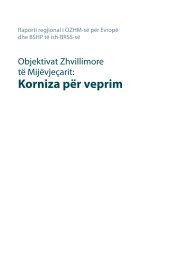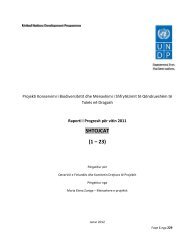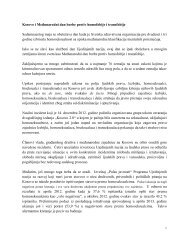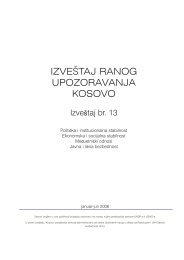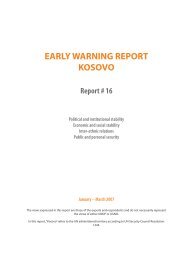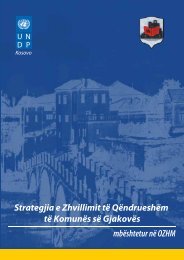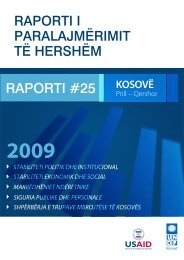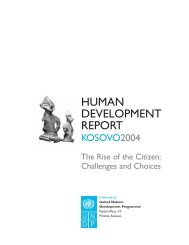Kosovo Human Development Report 2010 - UNDP Kosovo - United ...
Kosovo Human Development Report 2010 - UNDP Kosovo - United ...
Kosovo Human Development Report 2010 - UNDP Kosovo - United ...
Create successful ePaper yourself
Turn your PDF publications into a flip-book with our unique Google optimized e-Paper software.
FIGURe<br />
2.1<br />
Households<br />
report also identifies that poverty and<br />
vulnerability levels would be much<br />
higher without the safety net provided<br />
through migration and remittances.<br />
Poverty in <strong>Kosovo</strong> remains largely a rural<br />
phenomenon 41 disproportionately<br />
affecting large families, female headed<br />
households, people with disabilities,<br />
unemployed persons, precarious job<br />
holders (mainly ‘per diem’ workers) and<br />
self-employed agricultural households.<br />
The peculiarities of <strong>Kosovo</strong>’s economic<br />
context – rising GDP but stagnant<br />
poverty and unemployment rates<br />
- point to exclusion as a factor undermining<br />
inclusive economic growth.<br />
Since economic exclusion is necessarily<br />
more complex than economic deprivation<br />
(poverty), this chapter seeks to understand<br />
the mechanisms that underlie<br />
and perpetuate it – before looking to<br />
solutions.<br />
2.2<br />
Mechanisms and<br />
drivers of economic<br />
and labour market<br />
exclusion<br />
Identifying social exclusion mechanisms<br />
in transitional countries is always<br />
Two mainstream economic processes: factor and goods and services markets<br />
36 | KOSOVO HUMAN DEVELOPMENT REPORT <strong>2010</strong><br />
Goods and service<br />
markets (bread, clothing,<br />
transportation etc.)<br />
Consumption Purchases<br />
Factor markets (labour,<br />
land etc.)<br />
Wage, rent, profits etc.<br />
a challenging exercise. The data on<br />
economic exclusion are often distorted<br />
by such factors as the underground<br />
economy, un-reported remittances,<br />
and poorly developed statistical and<br />
social protection systems. To identify<br />
socially excluded groups in the economic<br />
area, the analysis seeks to map<br />
groups excluded from two essential<br />
and mainstream economic processes,<br />
namely:<br />
1. all factor markets/ factors of production<br />
such as labour, land, capital;<br />
and<br />
2. the ability to purchase necessary<br />
goods and services.<br />
The most severe form of exclusion is<br />
exclusion from all factor markets: i.e., an<br />
excluded individual or household cannot<br />
participate in any normal production<br />
proceses, and does not earn any<br />
income through profit, wages, rent or<br />
interest. Exclusion from all factor markets<br />
usually (but not always) leads to<br />
the second form of exclusion – inability<br />
to purchase necessary goods and<br />
services. This form of exclusion is essentially<br />
synonymous with poverty – the<br />
Businesses



